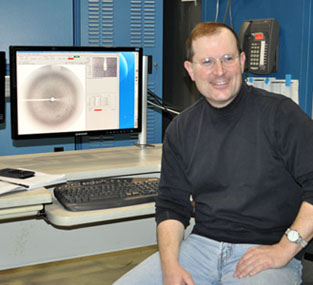Grover L. Waldrop
Professor
BMB Division
PhD: State University of New York, 1988
Phone: 225-578‐5209
Lab Phone: 225-578‐5214/9111
Office: 509 Choppin Hall
Lab: 507/511/527 Choppin Hall
E-mail: gwaldro@lsu.edu
Area of Interest
The research in this laboratory focuses on the catalytic mechanisms of enzymes from a kinetic, chemical and structural perspective. Currently, the laboratory is focusing on two enzymes both of which have medical relevance. One enzyme is acetyl CoA carboxylase, which catalyzes the committed and regulated step in fatty acid synthesis in all animals, plants and bacteria. This enzyme is a target for antibiotics and anti-obesity agents. Acetyl CoA carboxylase is a multifunctional biotin-dependent enzyme and consists of three components: (1) biotin carboxylase, (2) biotin carboxyl carrier protein, which contains the biotin cofactor and (3) carboxyltransferase. The other enzyme under investigation is GDP-mannose 4,6 dehydratase, which catalyzes the first committed step in the biosynthesis of fucose. This enzyme is a target for anti-inflammatory drugs and anti-metastatic agents. To study the catalytic mechanism of these enzymes we use a variety of mechanistic techniques including steady-state and rapid reaction kinetics, inhibitor design, isotope effects and site-directed mutagenesis. Structural analyses are carried out by x-ray crystallography.
Selected Publications
Mechanism of Biotin Carboxylase Inhibition by ethyl 4-[[2-chloro-5-(phenylcarbamoyl)phenyl]sulphonylamino]benzoate. Craft, M.K. and Waldrop, G.L. (2022) Journal of Enzyme Inhibition and Medicinal Chemistry, 37, 100-108.
Kinetics of Enzyme Inhibition. Waldrop, G.L. (2021). Encyclopedia of Biological Chemistry, Vol. 3, 14-20. Elsevier Inc.
Optimization and Mechanistic Characterization of Pyridopyrimidine Inhibitors of Bacterial Biotin Carboxylase. Andrews, L.D., Kane, T.R., Dozzo, P., Haglund, C.M., Hilderbrandt, D.J., Linsell, M.S., Machajewski, T., McEnroe, G., Serio, A.W., Wlasichuk, K.B., Neau, D.B., Pakhomova, S., Waldrop, G.L., Sharp, M., Pogliano, J., Cirz, R. and, Cohen, F. (2019). J. Med. Chem., 62, 7489-7505.
Acetyl-CoA Carboxylase from Escherichia coli Exhibits a Pronounced Hysteresis when Inhibited by Palmitoyl-Acyl Carrier Protein. Evans, A., Ribble, W, Schexnaydre, E. and Waldrop, G.L. (2017). Arch. Biochem. Biophys., 636, 100-109.
The Crystal Structure of Carboxyltransferase from Staphylococcus aureus Bound to the Antibacterial Agent Moiramide B. Silvers, M.A., Pakhomova, S., Neau, D.B., Silvers, W.C., Anzalone, N., Taylor, C.M. and Waldrop G.L. (2016). Biochemistry, 55, 4666-4674.
Structural Analysis of Substrate, Reaction Intermediate and Product Binding in Haemophilus influenzae Biotin Carboxylase. Broussard, T.C., Pakhomova, S., Neau, D.B., Bonnot, R., and Waldrop, G.L. (2015). Biochemistry, 54, 3860-3870.
Design, Synthesis, and Antibacterial Properties of Dual-Ligand Inhibitors of Acetyl-CoA Carboxylase. Silvers, M.A., Robertson, G.T., Taylor, C.M. and Waldrop, G.L. (2014). J. Med. Chem. 57, 8947-8959.
Computational Redesign of Bacterial Biotin Carboxylase Inhibitors Using Structure-Based Virtual Screening of Combinatorial Libraries. Brylinski, M. and Waldrop, G.L. (2014). Molecules 19, 4021-4045.
The Three-Dimensional Structure of the Biotin Carboxylase-Biotin Carboxyl Carrier Protein Complex of E. coli Acetyl-CoA Carboxylase. Broussard, T.C., Kobe, M.J., Pakhomova, S., Neau, D.B., Price, A.E., Champion, T.S. and Waldrop, G.L. (2013). Structure 21, 650-657.
Complex Formation and Regulation of Escherichia Coli Acetyl-CoA Carboxylase. Broussard, T.C., Price, A.E., LaBorde, S.M. and Waldrop, G.L. (2013). Biochemistry 52, 3346-3357.
A Capillary Electrophoretic Assay for Acetyl Coenzyme A Carboxylase. Bryant, S.K., Waldrop, G.L. and Gilman, S.D. (2013). Analytical Biochemistry 437, 32-38.
The Enzymes of Biotin Dependent CO2 Metabolism: What Structures Reveal about their Reaction Mechanisms. Waldrop, G.L., Holden, H.M. and St. Maurice, M. (2012). Protein Sci. 21, 1597-1619.
Acetyl-CoA Carboxylase as a Target for Antibacterial Development. Waldrop, G.L. (2012). In G. Tegos and E. Myolonakis (Eds.), Antimicrobial Drug Discovery: Emerging Strategies (pp. 208-219) Oxfordshire, UK: CAB International.
A Tale of Two Functions: Enzymatic Activity or Translational Repression by Carboxyltransferase. Meades, G., Benson, B.K., Grove, A., and Waldrop, G.L. (2010). Nucleic Acids Res. 38, 1217-1227.
Kinetic Mechanism and Structural Requirements of the Amine-Catalyzed Decarboxylation of Oxaloacetic Acid. Thalji, N.K., Crowe, W.E. and Waldrop, G.L. (2009). J. Org. Chem. 74, 144-152.
A Qualitative Approach to Enzyme Inhibition. Waldrop, G.L. (2009). Biochem. and Mol. Biol. Educ. 37, 11-15.
Molecular Dynamics Simulations of Biotin Carboxylase. Nilsson Lill, S.O., Gao, J. and Waldrop, G.L. (2008). J. Phys. Chem. B 112, 3149-3156.
Modeling and Numerical Simulation of Biotin Carboxylase Kinetics: Implications for Half-Sites Reactivity. de Queiroz, M.S. and Waldrop, G.L. (2007). J. Theor. Biol. 246, 167-175.